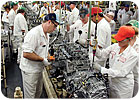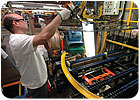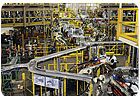
If you practice yoga, flexibility is extremely important. Bending and stretching helps people accomplish difficult poses such as downward-facing dog or the standing half-moon.
Flexible thinking is equally important in today’s complex business world. In fact, Roland Berger Strategy Consultants GmbH (Munich, Germany) recently conducted a study in which it discovered that the key to success in a slow economy is flexibility.
“Companies that react quicker to changes in the market are able to stay solidly in the black,” says Thomas Ring, a partner in Roland Berger’s operations strategy competence center. “The best companies actually act against the cycle, using their competitors’ weaknesses to strengthen their own position.
“In a rapidly changing environment, the ability to shift from growth plan to capacity cutting and back when the market recovers is becoming a competitive success factor,” adds Ring. “Global competition drives the speed of changed market requirements. The ability to quickly adjust is critical to leverage market cycles and sustain earnings, even during downturns.”
As markets increasingly become less predictable, Ring says flexibility will become even more critical to manufacturers. Flexible assembly lines allow companies to react quickly to shifting customer demands and short product life cycles. A flexible machine can be easily changed to adapt to new production processes or product designs.
Typically, a flexible assembly system consists of a standard platform and a series of interchangeable process and test modules that can be removed, modified and replaced quickly and easily. It allows for the future assembly of similar, possibly unrelated or currently undefined products.
Unfortunately, machine builders, systems integrators and their customers often have different definitions and ideas about “flexibility.” “It means different things to different customers in different industries,” says Jim Diederich, vice president of marketing at Assembly and Test Worldwide (Dayton, OH). “There are multiple definitions of the word, even within the same companies.
“We’ve seen opinions about ‘flexibility’ differ from the people writing up initial specs to the people signing off on finished equipment,” Diederich points out. To avoid problems and confusion, he urges manufacturing engineers to ensure that everyone in their plant shares the same goals and objectives with flexible assembly lines.
“Flexibility implies more than just product, process, lot-size and routing flexibilities,” claims Frank Chen, Ph.D., director of the Center for Advanced Manufacturing and Lean Systems at the University of Texas at San Antonio. “It is how a manufacturing system can cope with rapid changes of customer demands in both product styling and quantities, and how easily the system can be reconfigured to have higher automation or higher labor content.
“Productivity cannot be gained via implementing flexible manufacturing,” notes Chen, who has been studying flexible manufacturing systems since the 1980s. “Rapid customer response and shorter time to market are the real incentives for implementing flexible [assembly lines].”
Mark Dinges, product marketing manager for linear motion and assembly technologies at Bosch Rexroth Corp. (Buchanan, MI), agrees with Chen. “Manufacturers are constantly pressed with supplying smaller and more complex products,” he points out. “However, the greatest pressure actually comes from reducing time to market. As product life cycles continue to shrink, successful manufacturers must utilize a flexible production system to get their products to market faster and to stay competitive.
“The ultimate goal of flexible manufacturing is to provide the right product to the right customer at the right time,” adds Dinges. “Lean thinking is involved here, because supplying the right product at the right time includes the concept of manufacturing to customer takt time, and the ability to ramp up or scale back production to meet the level of customer demand.”

Flexible Champions
When it comes to building complex products and meeting customer needs, it’s impossible to overlook the auto industry, which has been implementing various forms of flexible assembly lines for the past decade. Today, automakers must assemble a greater mix of vehicles in a shrinking number of plants.More types of vehicles are available than ever and new products proliferate every year to address diverse consumer tastes. Indeed, there are more niche segments, platforms and nameplates on the market today than 20 years ago.
According to J.D. Power and Associates (Westlake Village, CA), more than 300 different models were available in the United States in 2008 vs. 216 in 1993. Between 1985 and 2004, average annual sales per vehicle nameplate dropped from 106,819 to 48,626. By 2010, that number is expected to drop to 40,000.
“The goal of flexible production is to balance capacity with demand to meet market fluctuations,” says John Lucci, a partner at Oliver Wyman Inc. (Troy, MI), a consulting firm that conducts the annual Harbour Report on manufacturing efficiency. “Flexibility is more important than ever, as witnessed by the recent spike and drop in gas prices. As multiple propulsion systems, ranging from gas and hybrid to electric and diesel, proliferate in the industry, flexible assembly lines will become even more essential to automakers and suppliers.”
In a flexible environment, vehicles are put together the same way, with shared components and standardized assembly equipment. Multiple vehicle segments-cars, sport-utility vehicles (SUVs), minivans, pickup trucks and crossover vehicles-can be built off the same architecture. Variability in body styles and sizes, chassis sizes, interiors and other differences are easily accommodated. That flexibility translates into tremendous cost savings and reduced downtime during product changeover.
However, flexible assembly has been easier said than done in the auto industry. The Big Three have been talking about their flexible factories for years. Indeed, back in 2002, a senior executive at Ford Motor Co. (Dearborn, MI) told ASSEMBLY that “achieving genuine flexibility is vital to any future scenario. And we’re committed to getting there in the shortest possible time.”
During the last seven years, Ford has spent millions of dollars retooling its assembly plants and body shops. But, last year, when the market suddenly shifted from large pickups and SUVs to small cars, the automaker wasn’t flexible enough to immediately shift production like some of its Japanese competitors.
Ford is currently investing $75 million to retool a truck plant in Wayne, MI, for small-car production. It’s one of three Ford plants in North America that are being converted to build fuel-efficient cars. “At the heart of this manufacturing transformation is a flexible operation,” claims Joe Hinrichs, group vice president of global manufacturing and labor affairs at Ford.
Despite numerous investments, American automakers still lag behind their Japanese competitors when it comes to flexible manufacturing. “Japanese automakers are very good at working with suppliers in a collaborative effort,” says Lucci. “That makes suppliers more flexible. The Japanese are also better at leveling their production schedules. That makes it easier to predict demand and go to smaller batch sizes. They also excel when it comes to standardized work.”
While U.S. assembly lines are more flexible than they were a decade ago, the Big Three are still far behind the flexibility curve, claims Laurie Harbour-Felax, president of the Harbour-Felax Group (Berkley, MI). “They’ve all made huge progress, but they’re not yet where they need to be. Everyone is at different stages of the game. In addition, most suppliers are not where they need to be.”
According to Harbour-Felax, the two most flexible automakers in the world are Honda Motor Co. (Tokyo) and Toyota Motor Corp. (Nagoya, Japan). She says most of their flexibility efforts have focused on their body shops.
“The key is the framing station,” Harbour-Felax points out. “For instance, Toyota has developed a flexible system that allows it to build eight different vehicle architectures on the same assembly line. They use a spider-like mechanism that welds parts from the inside of each vehicle rather than from the outside.”
Toyota also continuously tunes the flexibility of its assembly plants by applying lean tools and principles. The automaker recently embarked on a continuous improvement crusade at it Takaoka plant in Toyota City, Japan, which builds numerous vehicles, such as the Corolla and the Vitz. When the makeover is complete, the extremely flexible facility will build more models, faster, on shorter assembly lines than other Toyota plants.
By investing in a network of highly flexible assembly plants, Honda has enhanced its ability to quickly respond to changes in customer demand, while also ensuring more efficient use of overall production capacity. The automaker’s facilities in Ohio and Ontario are capable of building cars and light trucks on the same line.
During the recent turmoil in the auto industry, while many manufacturers struggled to cut capacity and scrambled to build different vehicle platforms, Honda calmly sat back and relied on the benefits of its flexible production system. For instance, earlier this year, the automaker shifted production of its Ridgeline pickup from Alliston, ON, to Lincoln, AL. The Alabama plant previously assembled the Odyssey minivan and the Pilot SUV. Later this year, the majority of V-6 Accord sedan production will shift from Honda’s Marysville, OH, plant to the Alabama facility. The Ohio plant will increase its production of four-cylinder Accord sedans in mid-2009, decreasing imports of Accords to the United States in response to fluctuating currency rates and shipping costs.
“These moves are part of a series of production adjustments that [we are] making in North America to meet customer demand for fuel-efficient passenger cars and light trucks, as well as to ensure the most efficient use of [our] manufacturing capacity,” says John Mendel, executive vice president of American Honda Motor Co. (Torrance, CA). “We are leveraging our flexible manufacturing network to meet the needs of our customers.”

Fundamentals of Flexibility
Many of the basic principles of flexible manufacturing used in the auto industry also apply to other products and production processes. “The fundamentals of flexibility hold up whether you’re making cars or eyeglasses,” says Lucci.
Indeed, flexible assembly has been successfully adopted by manufacturers in many other industries, ranging from consumer electronics to medical devices. Both of those industries tend to turn over their designs with new and improved models after a relatively short product life.
Any market where technology is changing quickly, such as cell phones, is ideal for flexible production. As a rule of thumb, products that contain subassemblies that require the same basic parts and processes as other subassemblies, such as electric motors, generally are good candidates for flexible manufacturing. That’s why many solar panel manufacturers are implementing flexible assembly lines as they ramp up production.
To enable flexibility, manufacturers need equipment designed to accept change requests. For instance, modular conveyors are much easier to expand or reconfigure than rotary dial machines or other fixed automation. Other assembly tools, such as robots, linear motors, machine vision and motion controls, make it easier to be flexible today than in the past. “But, there’s still a lot of misunderstanding about what flexibility is and is not,” says Harbour-Felax.
Before implementing flexible assembly lines, manufacturing engineers should carefully consider all the pros and cons. For instance, traditional assembly equipment is limited by attributes such as processes, motions, precision, cycle rates, part size and weight, and component feeding. However, a dedicated machine is typically less expensive than a flexible machine.
There are some overlooked costs associated with flexible equipment. For example, wiring can be extremely expensive; installation costs can run anywhere from $10 to $1,000 per foot, depending on the type of application. On a typical assembly line, that easily translates into thousands of dollars. If a line needs to be reconfigured, that work will need to be redone. That’s one reason why some manufacturers are investing in wireless technology.
Efficiency is another trade-off that needs to be carefully considered. Highly flexible systems may be unable to match the speed of hard tooling. Compared with a dedicated machine, a flexible piece of equipment often has a larger ratio of size vs. throughput. As production volume increase, flexibility decreases. If annual production volume is at least 5 million units, or if the product’s market life is expected to be at least 5 years, manufacturers may be better off with a dedicated machine.
“Slow applications tend to work the best with flexible automation,” says Bob Rice, applications team leader at Automation Tool Co. (Cookeville, TN). “Contrary to popular opinion, manual operations are the ideal form of flexibility. Robots are the biggest flexible tool in the automation world, but they also have limits, such as parts feeding. Operators still do most things better than a robot.”
“Parts feeding is the most challenging thing that limits flexibility, but new technology holds promise,” claims Mark Handelsman, industrial marketing manager at FANUC Robotics America Inc. (Rochester Hills, MI). “Flexible feeding and 3D vision are becoming more prevalent, especially in applications where parts can vary in dimension or have a contour.” Force control is another technology that improves flexibility.
“Hard tooling solutions have their place and will continue,” notes David Huffstetler, market manager at Stäubli Robotics (Duncan, SC). “However, our appetite for quick delivery of new products demands flexibility. Choosing the correct technology is paramount, because of the design decisions that will be made later.
“The key to maximizing a robot arm’s flexibility begins at the design stage,” explains Huffstetler. “Speed, dexterity of envelope and quality of motion performance are often-overlooked parameters when considering which robot to build your cell around. Understanding these items will attribute to an optimized workcell. While there is no doubt that programming flexibility is paramount to success, long-term reliability and capability in the mechanics is what will be important to realize the true benefits of a flexible design.”
Typically, the first stage of flexible assembly is the most flexible. As volume increases and automatic stations are added, a machine often becomes less flexible and requires more time and effort to retool.
Motion control also plays a key role in achieving flexibility. Instead of using pneumatic actuators or cams, servo-driven actuators enable engineers to change motions simply by entering a new value in the control software. However, servomotors are typically more expensive than pneumatic actuators.
Fixtures are also critical to flexible assembly systems. Adjustable fixtures feature one or more sides built on slides so that the length and width of the fixture can be quickly changed. Multipiece, adjustable fixtures are more expensive than off-the-shelf fixtures.
“Product design is critical to flexibility,” Lucci points out. “You need common access points for tooling and common end points for fixtures.” A
To learn more about flexible manufacturing, search for these articles at www.assemblymag.com:
-
A New Take on Flexibility.
-
Extreme Flexibility.
-
- Flexible Challenges.
- Ford Gets Flexible in Louisville.
- Flexible Challenges.
-
Going Wireless.
-
How to Measure Flexibility.
-
Is Flexibility a Myth?
-
Some Change Is Good; Too Much Is Bad.
- The Role of Robotics in Flexible Manufacturing.
